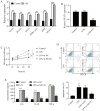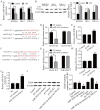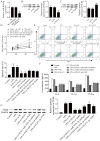Long non-coding RNA NEAT1 contributes to lipopolysaccharide-induced inflammation and apoptosis of human middle ear epithelial cells via regulating the miR-301b-3p/TLR4 axis
- PMID: 34659506
- PMCID: PMC8515508
- DOI: 10.3892/etm.2021.10795
Long non-coding RNA NEAT1 contributes to lipopolysaccharide-induced inflammation and apoptosis of human middle ear epithelial cells via regulating the miR-301b-3p/TLR4 axis
Abstract
Acute otitis media (AOM) is a common infectious disease in children that is accompanied by signs and symptoms of middle ear inflammation and infection. Previous studies have shown that the long non-coding (lnc)RNA nuclear-enriched abundant transcript 1(NEAT1) participates in various inflammatory conditions and plays an important regulatory role. The focus of the present study was the biological function of NEAT1 and underlying molecular mechanism in lipopolysaccharide (LPS)-induced human middle ear epithelial cells (HMEECs). The expression of NEAT1, miR-301b-3p and toll-like receptor 4 (TLR4) protein were determined by reverse transcription-quantitative PCR and western blot assays, respectively. Dual-luciferase reporter assay was performed to investigate the combination of miR-301b-3p and NEAT1 or TLR4. In addition, cell viability, apoptosis and the levels of pro-inflammatory factors (IL-1β, TNF-α and IL-6) were measured by Cell Counting Kit-8 assay, flow cytometry and ELISA, respectively. Cell viability was significantly decreased, whereas apoptosis and inflammation were increased in LPS-stimulated HMEECs. Functional analyses demonstrated that NEAT1 was upregulated following LPS treatment, whereas knockdown of NEAT1 significantly increased cell viability and alleviated apoptosis and inflammation. Mechanistically, NEAT1 directly bound to and negatively regulated miR-301b-3p expression, whereas miR-301b-3p inhibitors abolished the inhibitory effect of NEAT1 knockdown on cell apoptosis and inflammation. As a target of miR-301b-3p, TLR4 was regulated by NEAT1 and miR-301b-3p. TLR4 overexpression alleviated NEAT1 silencing-induced inflammatory suppression. Rescue experiments demonstrated that NEAT1 promoted TLR4 expression by inhibiting miR-301b-3p. Collectively, the results of the present study suggested that NEAT1 may attenuate LPS-induced inflammation and apoptosis in HMEECs by modulating the miR-301b-3p/TLR4 axis, and may provide a new therapeutic target for the clinical treatment of AOM.
Keywords: acute otitis media; human middle ear epithelial cells; miR-301b-3p; nuclear-enriched abundant transcript 1; toll-like receptor 4.
Copyright: © Liu et al.
Conflict of interest statement
The authors declare that they have no competing interests.
Figures




Similar articles
-
Circ_KATNAL1 promotes the inflammation and apoptosis in human middle ear epithelial cells induced by lipopolysaccharide by regulating the miR-153-3p / TLR4 axis.Cell Mol Biol (Noisy-le-grand). 2023 Aug 31;69(8):172-178. doi: 10.14715/cmb/2023.69.8.26. Cell Mol Biol (Noisy-le-grand). 2023. PMID: 37715400
-
Long non-coding RNA NEAT1/miR-193a-3p regulates LPS-induced apoptosis and inflammatory injury in WI-38 cells through TLR4/NF-κB signaling.Am J Transl Res. 2019 Sep 15;11(9):5944-5955. eCollection 2019. Am J Transl Res. 2019. PMID: 31632562 Free PMC article.
-
LncRNA NEAT1 promotes apoptosis and inflammation in LPS-induced sepsis models by targeting miR-590-3p.Exp Ther Med. 2020 Oct;20(4):3290-3300. doi: 10.3892/etm.2020.9079. Epub 2020 Jul 29. Exp Ther Med. 2020. PMID: 32855700 Free PMC article.
-
Defining the transcriptional routes controlling lncRNA NEAT1 expression: implications in cellular stress response, inflammation, and differentiation.Discov Oncol. 2025 May 15;16(1):768. doi: 10.1007/s12672-025-02510-6. Discov Oncol. 2025. PMID: 40369379 Free PMC article. Review.
-
Novel Insights into the Emerging Role of Neat1 and Its Effects Downstream in the Regulation of Inflammation.J Inflamm Res. 2022 Jan 26;15:557-571. doi: 10.2147/JIR.S338162. eCollection 2022. J Inflamm Res. 2022. PMID: 35115805 Free PMC article. Review.
Cited by
-
Role and Therapeutic Potential of miR-301b-3p in Regulating the PI3K-AKT Pathway via PIK3CB in Eosinophilic Chronic Rhinosinusitis.J Inflamm Res. 2025 Jul 30;18:10235-10251. doi: 10.2147/JIR.S521536. eCollection 2025. J Inflamm Res. 2025. PMID: 40756418 Free PMC article.
-
CircRNA RERE Promotes the Oxidative Stress-Induced Apoptosis and Autophagy of Nucleus Pulposus Cells through the miR-299-5p/Galectin-3 Axis.J Healthc Eng. 2021 Dec 15;2021:2771712. doi: 10.1155/2021/2771712. eCollection 2021. J Healthc Eng. 2021. Retraction in: J Healthc Eng. 2022 Dec 11;2022:9795132. doi: 10.1155/2022/9795132. PMID: 34956563 Free PMC article. Retracted.
-
Roles of long noncoding RNAs in human inflammatory diseases.Cell Death Discov. 2024 May 15;10(1):235. doi: 10.1038/s41420-024-02002-6. Cell Death Discov. 2024. PMID: 38750059 Free PMC article. Review.
References
LinkOut - more resources
Full Text Sources
Research Materials
